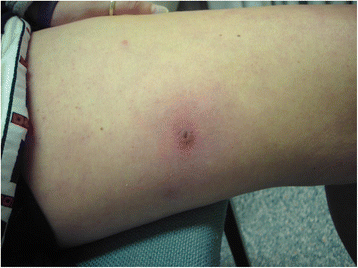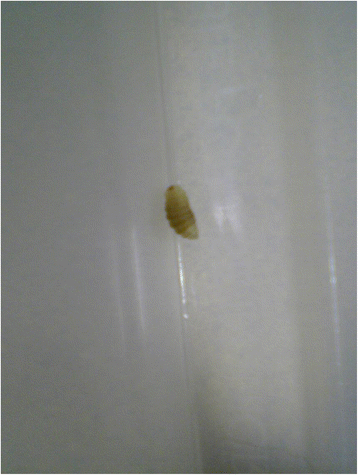An exotic abscess within the United Kingdom from The Gambia: a case report
- PMID: 29096711
- PMCID: PMC5668963
- DOI: 10.1186/s13256-017-1472-3
An exotic abscess within the United Kingdom from The Gambia: a case report
Erratum in
-
Correction to: An exotic abscess within the United Kingdom from The Gambia: a case report.J Med Case Rep. 2018 Jan 31;12(1):25. doi: 10.1186/s13256-018-1565-7. J Med Case Rep. 2018. PMID: 29386052 Free PMC article.
Abstract
Background: Furuncular myiasis is a parasitic infection of a live mammal by fly larvae commonly seen in Africa. However, with an increase in international tourism, there is a significant rise in exotic infection in non-endemic areas which can pose a diagnostic challenge to doctors and potentially lead to delay in treatment. From the current literature, only 12 cases were reported in the UK.
Case presentation: We report an unusual case of multiple abscesses in a 32-year-old white British woman presenting to our Emergency department in the UK after returning from a holiday in The Gambia, West Africa. She did not complain of systemic symptoms and was otherwise fit and healthy with no significant past medical history. During examination, two maggots were expressed from the abscesses by applying lateral pressure to each lesion. The larvae were found to be Cordylobia anthropophaga. She was discharged with antibiotics to prevent secondary infection with no further follow-up.
Conclusion: With globalization, the need for increasing awareness of tropical diseases has become important to win the battle against future epidemics.
Keywords: Cordylobia anthropophaga; Furuncular myiasis; Gambia; Tumbu fly.
Conflict of interest statement
Ethics approval and consent to participate
Not applicable.
Consent for publication
Written informed consent was obtained from the patient for publication of this case report and accompanying images. A copy of the written consent is available for review by the Editor-in-Chief of this journal.
Competing interests
The authors declare that they have no competing interests.
Publisher’s Note
Springer Nature remains neutral with regard to jurisdictional claims in published maps and institutional affiliations.
Figures
References
-
- World Tourism Organization . Compendium of tourism statistics, 1992–1996. 18. Madrid: World Tourism Organization; 1998.
Publication types
MeSH terms
Substances
Supplementary concepts
LinkOut - more resources
Full Text Sources
Other Literature Sources
Medical
Miscellaneous



